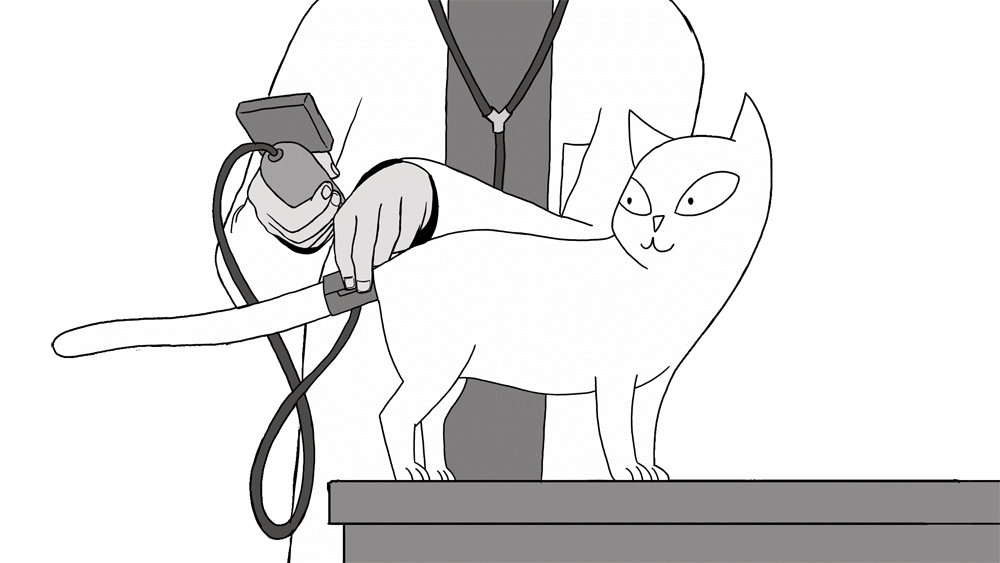Important to Know: High Blood Pressure in Cats
In this section we give a deeper look at specific conditions to help raise awareness of what is out there, what can be done and what tests can be used to improve our pets’ health. This month it is feline Hypertension.
Quick read - Hypertension
· Hypertension is high blood pressure
· Untreated it can cause organ damage, sudden blindness or death
· It affects 1 in 5 cats older than 9
· It often is caused by other diseases such as hyperthyroidism or renal disease
· Treatment is with a tablet: Amlodipine besylate
· Frequent blood pressure measurement is needed to identify cases of hypertension
Hypertension in Cats
Hypertension is commonly known as having High Blood Pressure. Well documented and measured in humans, few experienced cat owners are aware of how hypertension can affect their pets, and fewer still have their pet’s blood pressure monitored regularly.
What is it:
Hypertension is caused by an increase in blood pressure in the arteries of the body, hyper- means high, and tension refers to the pressure being exerted. In healthy cats, periods of hypertension and hypotension (low blood pressure) are regulated by complex interactions between the brain, heart, kidneys and blood vessels, specifically by the Renin-Angiotensin-Aldosterone-system (figure 1).
Functioning normally, blood pressure for cats should be in the range 80-160mmHG. If blood pressure is raised above this level for long periods of time, we consider this to be a disease state.
What happens in the disease?
Prolonged high blood pressure is a risk because it can cause organ damage, particularly to the eyes, kidneys, heart and brain. In severe cases, hypertension can lead to sudden blindness or even death. Because hypertension can stay unnoticed, it often gets called the silent killer.
Idiopathic or Secondary?
It is estimated that 1 in 5 cats over the age of 9 is at risk of hypertension. A staggering number!
In cats, 80 to 90% of cases of hypertension are secondary hypertension cases, and investigations identify other diseases that have caused the high blood pressure. In the rest, these are known as idiopathic, or “unknown cause” of the disease.
In those with a secondary disease, kidney disease is most commonly identified, with overactive thyroid, hyperthyroidism, a close second.
How is it diagnosed:
As with humans, diagnosis is achieved through regular blood pressure monitoring. A small cuff is placed around your cat’s leg or tail and the blood flow is listened to through a sensitive probe. If the blood pressure is identified to be higher than 160mmHg on three attempts to measure it, hypertension can be diagnosed.
Complicating the diagnosis- White Coat Syndrome!
Whilst simple, other things can cause our cats to have high blood pressure. Most commonly the trip to a vet practice can be stressful to cats. A combination of not being used to the travel and the needed restraint and cuff can cause our cats to have high heart rates, and thus higher blood pressures! As a result, a quiet room, allowing a small amount of time for cats to acclimatise to the building, and in some cases a full day stay in the hospital is needed to get an accurate reading.
How is hypertension treated?
If high blood pressure is identified, then a urine sample and blood sample to assess kidney and thyroid function is essential. Other investigations may be required following the blood tests to determine if any other disease may be causing hypertension.
Once investigations have been carried out, or during the investigation process, hypertension treatment is made using amlodipine besylate. This medication is used to reduce the measured blood pressure to below 160mmHg. The goal is to minimise the risk of secondary damage such hypertension can cause.
What can I do?
Regular blood pressure checks are the only means to identify blood pressure levels quickly. For cats over the age of 9, screening checks every 6 months is currently recommended, with cats having concurrent diseases benefiting from checks every 3 months.
Conclusion
Hypertension is an under-identified affecting many older cats. Known as the silent killer, the only means to identify it is through regular blood pressure checks. Once identified blood pressure can be moderated by using amlodipine besylate and ongoing blood pressure assessments.



